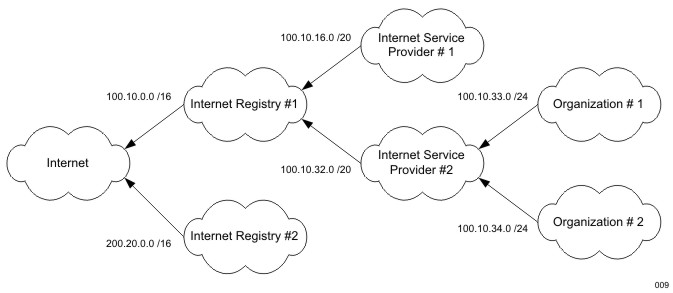As implemented by IPv4, CIDR
-
Eliminates the traditional concept of classful addresses (that is, Class A, B, or C addresses) and replaces them with the generalized concept of a network-prefix
-
Supports route aggregation of perhaps thousands of traditional classful routes. A single routing table entry can specify many individual network addresses.
CIDR uses the network-prefix rather than the first 3 bits of the IP address to determine the division between the network-number and the host-number. It can support the deployment of arbitrarily sized networks rather than the fixed-size Class A (/8), B (/16), or C (/24) classful networks.
CIDR advertises a bit mask with each piece of routing information. Routers that support CIDR do not make any assumptions based on the first 3 bits of a destination address, relying only on the prefix-length associated with the route. Network prefixes are viewed as bitwise contiguous blocks of the IP address space. Using CIDR, IPv4 CIDR Supernet/Subnet Table can be developed. The table itemizes all the potential supernets/subnets available within the IPv4- addressing space. Additional information is provided for Hex and Decimal values, classful equivalents, and number of addresses available within the indicated block. All of the network-prefixes from 1 to 32 are provided.
Table 3. IPv4 CIDR Supernet/Subnet Table
|
Mask Value: Hex |
CIDR Prefix |
Dotted Decimal |
# of Addresses |
# of Classful |
|---|---|---|---|---|
|
80.00.00.00 |
/1 |
128.0.0.0 |
2048 M |
128 A |
|
C0.00.00.00 |
/2 |
192.0.0.0 |
1024 M |
64 A |
|
E0.00.00.00 |
/3 |
224.0.0.0 |
512 M |
32 A |
|
F0.00.00.00 |
/4 |
240.0.0.0 |
256 M |
16 A |
|
F8.00.00.00 |
/5 |
248.0.0.0 |
128 M |
8 A |
|
FC.00.00.00 |
/6 |
252.0.0.0 |
64 M |
4 A |
|
FE.00.00.00 |
/7 |
254.0.0.0 |
32 M |
2 A |
|
FF.00.00.00 |
/8 |
255.0.0.0 |
16 M |
1 A |
|
FF.80.00.00 |
/9 |
255.128.0.0 |
8 M |
128 B |
|
FF.C0.00.00 |
/10 |
255.192.0.0 |
4 M |
64 B |
|
FF.E0.00.00 |
/11 |
255.224.0.0 |
2 M |
32 B |
|
FF.F0.00.00 |
/12 |
255.240.0.0 |
1024 K |
16 B |
|
FF.F8.00.00 |
/13 |
255.248.0.0 |
512 K |
8 B |
|
FF.FC.00.00 |
/14 |
255.252.0.0 |
256 K |
4 B |
|
FF.FE.00.00 |
/15 |
255.254.0.0 |
128 K |
2 B |
|
FF.FF.00.00 |
/16 |
255.255.0.0 |
64 K |
1 B |
|
FF.FF.80.00 |
/17 |
255.255.128.0 |
32 K |
128 C |
|
FF.FF.C0.00 |
/18 |
255.255.192.0 |
16 K |
64 C |
|
FF.FF.E0.00 |
/19 |
255.255.224.0 |
8 K |
32 C |
|
FF.FF.F0.00 |
/20 |
255.255.240.0 |
4 K |
16 C |
|
FF.FF.F8.00 |
/21 |
255.255.248.0 |
2 K |
8 C |
|
FF.FF.FC.00 |
/22 |
255.255.252.0 |
1 K |
4 C |
|
FF.FF.FE.00 |
/23 |
255.255.254.0 |
512 |
2 C |
|
FF.FF.FF.00 |
/24 |
255.255.255.0 |
256 |
1 C |
|
FF.FF.FF.80 |
/25 |
255.255.255.128 |
128 |
½ C |
|
FF.FF.FF.C0 |
/26 |
255.255.255.192 |
64 |
1/4C |
|
FF.FF.FF.E0 |
/27 |
255.255.255.224 |
32 |
1/8 C |
|
FF.FF.FF.F0 |
/28 |
255.255.255.240 |
16 |
1/16 C |
|
FF.FF.FF.F8 |
/29 |
255.255.255.248 |
8 |
1/32 C |
|
FF.FF.FF.FC |
/30 |
255.255.255.252 |
4 |
1/64 C |
|
FF.FF.FF.FE |
/31 |
255.255.255.254 |
2 |
1/128 C |
|
FF.FF.FF.FF |
/32 |
255.255.255.255 |
Single host |
Single host |
Hosts that support CIDR permit supernetting, the configuration of a mask that identifies a prefix shorter than the natural mask associated with traditional classful addresses.
CIDR and VLSM are essentially the same thing — they both support the recursive division of the IP address space into subsequently smaller pieces. The difference is that with VLSM, the recursion takes place on the address space previously assigned to a domain (classful address block) and is invisible to the global Internet. CIDR instead supports the recursive allocation of the entire IP address space in a hierarchical manner (aggregation); from an Internet Registry to a high-level ISP, to a mid-level ISP, to a low-level ISP, and eventually to a private domain/network. Consider CIDR Routing Advertisements.
Since all of the routes within Organization # 1's domain are part of ISP # 2's address block, the routes to Organization # 1 are implicitly aggregated via ISP # 2's aggregated route announcement to Internet Registry # 1. Therefore, all of Organization # 1's networks are hidden behind a single routing advertisement from ISP # 2. In turn, all of the routes within ISP # 2 are implicitly aggregated via Internet Registry # 1's route announcement to the global Internet, hiding all of the routes behind and within Internet Registry # 1. From this, it is clear how growth of the Internet's routing table can be controlled using CIDR.
As with VLSM, CIDR requires that interior routing protocols carry the network-prefix information for each advertised route, implement a forwarding algorithm based on the “longest match” paradigm, and in order to provide route aggregation, assign addresses so that they are topologically significant.


